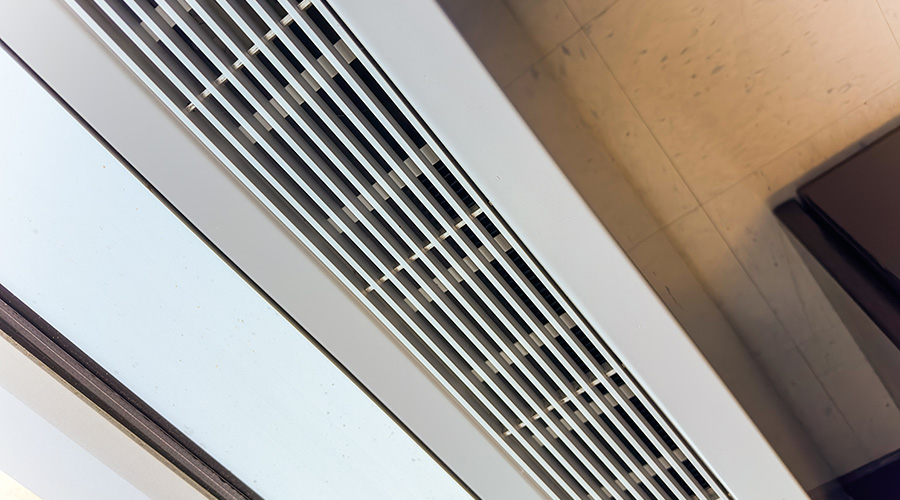5 Core Elements of Good Indoor Air Hygiene
The pandemic has emphasized the importance of an indoor air environment that supports healthy, happy, productive occupants.
The quality of the air we breathe in a building has always been of the utmost importance. That’s because, on average, we spend 90 percent of our time indoors. Given that percentage, our efforts toward indoor air hygiene have not always been as intense as they should be, especially in high occupancy buildings such as offices and school classrooms. The pandemic has highlighted the importance of hygienic air and the direct effects poor air quality has on the health and cognition of office workers and students. Additionally, poor air quality has been shown to incur colossal costs – some $10 billion a year – in terms of lost office productivity. How we manage indoor air going forward is key to creating spaces that will have a positive impact on human health, comfort, and productivity levels, at the same time ensuring those within can go about their activities safely. In short, we must go beyond indoor air quality, and strive to achieve indoor air hygiene.
The highest air quality standards should be the clear goal to facility managers. Historically, the focus has been on minimum acceptable standards for human occupancy to minimize energy costs, but in the light of the pandemic, this has been turned on its head, and rightly so. The primary goal should always be set on creating optimal conditions to maximize health, cognition, and productivity, with energy use a monitored secondary concern. Energy use is of course important, but the savings made in this area cannot offset the losses sustained through lost productivity. In any case, human health has to take priority if we are to reopen and stay open in the long term. This new priority requires us to extend our monitoring from how well our HVAC system is running to tracking air quality where the people are inside the building.
Most assessments of indoor air quality performance are a moment in time snapshot of current conditions, rather than an ongoing evaluation. They typically provide a review of the structure, the current HVAC system and its performance abilities, filters used, outdoor air ventilation, the use of air purifiers, and so on. Such an assessment is extremely valuable, but it fails to address two critical factors – how is the system actually run (vs. what it can do) and the reality that indoor air quality is not constant but varies throughout the day based on multiple factors. An assessment approach may tick a box on a given day, but to maintain a high air quality standard on an ongoing basis requires active and real-time monitoring of the air quality and an understanding of the key parameters of air quality and what levels to manage against, i.e. achieving air hygiene standards. This means that the quality of the air is not simply assessed and assumed. Rather, it is measured, monitored, and above all, it is managed. To do so, here are five best practices of good indoor air hygiene.
1 and 2. The heat AND the humidity
To achieve optimal indoor air hygiene there are five core parameters that must be factored into the air hygiene equation, the first two of which are widely known but not fully understood. They are temperature and humidity. Most of us think of temperature and humidity as comfort measures, although as individuals what comfortable means will vary.
A relative range of temperature comfort is 72°F plus/minus 3 to 4 degrees. Outside those ranges productivity can be impacted when we start to feel uncomfortably cold or hot. Temperature does not become a significant health concern until temperatures go below 40⁰F or above 100°F, which would be rare indoors unless the air management system has failed.
Humidity is a measurement of the amount of water in the air, and generally we will not “feel” it when it is in the 40 to 60 percent level. However, high levels of humidity create conditions that favor growth and spread of microbes such as mold. It is vital to include humidity within air hygiene assessments because of the impacts of these microbes and mold to our health.
3. Carbon dioxide – productivity killer
Have you ever felt sluggish sitting in a meeting room and refreshed after walking outdoors? It’s not a boring meeting, it’s the high levels of CO2 that build up in congested spaces. CO2 levels are impacted by occupancy rate, congestion, and the air management systems’ ability to bring in fresh outside air to replace the inside air. In general, as CO2 levels increase inside a building, cognition, productivity, learning, and test scores go down. Therefore it is recommended that indoor air CO2 should match outside air CO2 levels, or be close to it, as long as it is 600ppm or less.
One particular study, spearheaded by Joseph G. Allen, director of the Healthy Buildings program and an Associate Professor at Harvard's T. H. Chan School of Public Health, took 24 participants who spent six full workdays in an environmentally controlled office space. The study’s method outlined that the participants be blinded to test conditions and on different days the participants be exposed to indoor environmental quality conditions representative of either conventional or green office buildings in the United States: Conventional had high concentrations of volatile organic compounds (VOCs) and Green had low concentrations of VOCs. Additional conditions simulated a Green building with a higher outdoor air ventilation rate (labelled Green+) and artificially elevated carbon dioxide levels independent of ventilation.
The results were eye-opening: “Office workers had significantly improved cognitive function scores when working in Green and Green+ environments compared with scores obtained when working in a Conventional environment. Exposure to CO2 and VOCs at levels found in conventional office buildings was associated with lower cognitive scores than those associated with levels of these compounds found in a Green building. Using low-emitting materials, which is common practice in Green buildings, reduces in-office VOC exposures. Increasing the supply of outdoor air lowers exposures to not only CO2 and VOCs but also to other indoor contaminants.”
4. Why so volatile?
Volatile organic compounds, or VOCs, are gas phase pollutants in the air. Some VOCs are benign (like the terpenes you smell when peeling citrus fruits) and some can impact your health (such as formaldehyde). VOCs cannot be captured by filtration because gasses simply pass through filters. VOCs need to be exhausted outside, diluted with fresh air, or captured using gas phase adsorption media (such as carbon).
VOCs often accumulate indoors from what we refer to as off-gassing. VOCs can emanate out of everything from indoor furnishings to building materials. Other sources are cooking and evaporation out of chemicals such as nail polish, paint, cleaning agents, etc. If we take building materials as an example, some can emit VOC gasses such as formaldehyde and benzene for many years after their installation, and when you consider the Environmental Protection Agency’s opinion that concentrations of VOCs are consistently higher indoors (up to 10 times higher), it is clear why VOC-level is another important parameter to manage for optimal indoor air hygiene.
As with temperature and humidity, the senses come into play with many VOCs, in that you can smell them and so have an awareness of them at some concentration. However, because human perceptions vary, actual VOC levels are vital to measure, monitor, and manage in order to successfully mitigate their detrimental effects to occupants.
5. Particulates matter
Perhaps the most hidden of our five core parameters is Particulate Matter (PM), especially particulate under 2.5 microns in size (PM2.5). PM2.5 is usually considered the benchmark particle size to measure for clean, healthy air. This is because PM2.5 particles can penetrate deep into our lungs, creating serious health consequences. MERV 13 (or better) and preferably HEPA filters do an excellent job of removing PM from the air, and it is key to consider that filter rating and air circulation rate through the filter are ways to effectively manage PM2.5. Circulation rate is critical and often overlooked as most systems are only “on” while cooling or heating the air, as opposed to delivering a constant flow through the filters.
There have been several studies conducted on the effects of PM2.5, one of which was done by researchers including Professor Barbara Maher, from Lancaster University in the UK. Published in Neuroscience News. The study examined the brainstems of 186 Mexico City residents, young children or young adults, who were constantly exposed to air pollution. The results revealed markers of Alzheimer’s disease, Parkinson’s disease, and motor neuron disease, suggesting that air pollution poses a serious risk of neurological damage from an early age.
This is of course just one example, but it is a sobering reminder that to overlook air hygiene can have very serious health implications for people of all ages. Today, with regard to the current pandemic, and indeed the likelihood of pandemics in the future, the spotlight has turned to the importance of indoor air hygiene. We have our chance now to ensure it is treated seriously.
The message then, is that given the incredible amount of time we spend inside in today’s world, it would be negligent to ignore the quality of the air we breathe in those spaces. Measuring, monitoring, and managing indoor air is the only effective way to mitigate the risks of uncontrolled air quality. And only by approaching this with a serious eye toward indoor air hygiene will we enable safe, long-term return to business and educational spaces that have been empty for too long.
Todd DeMonte is chief innovation officer at the Indoor Air Hygiene Institute.
Related Topics:












